Is your new puppy cute? Of course they are. Is your puppy well behaved? Is your puppy well trained? These last 2 questions are what we ask every pet parent that brings their new puppy to our veterinary clinic. The answers are usually no, my puppy is a maniac. Or they might say that they are waiting until their puppy is older to start training them. They likely didn’t know that a recent study shows that puppy socialization and training can reduce canine behavior problems in the future
In this article, you’ll learn the first 7 commands for dog training, when to start training, and the tips, tricks, and secrets for success.
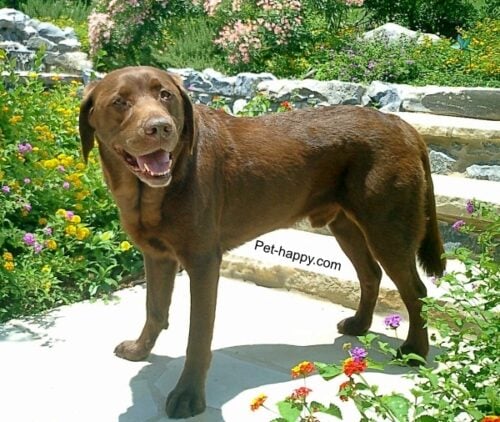
Table of Contents
How do you start training your dog?
When we got our first puppy, we were a very young couple and had no idea what we were doing. I was still in veterinary school. So we turned to the professionals and took a puppy training class. The soonest we could enroll our new puppy was 10 weeks. But we were determined to start training our puppy at 8 weeks when we brought him home. The reason for the delay of getting into the class was to ensure our puppy was completely vaccinated. The American Veterinary Society of Animal Behavior says that:
“In general, puppies can start socialization classes as early as 7-8 weeks of age. Puppies should receive a minimum of one set of vaccines at least 7 days prior to the first class and a first deworming. They should be kept up to date on all vaccines throughout the class.”
American Veterinary Society of Animal Behavior
We taught him many commands starting at 8 weeks of age by having short training sessions (due to his age and attention span). We would feed him his puppy food a few kernels at a time as a treat for performing the correct actions in response to a basic command. We also would teach the verbal command while giving him the corresponding hand signal. By the time he started puppy training, he knew how to Sit, Stay, Come, Down, Heel, Crate (see below), Shake, Spin, and High Five. At the end of the 4 weeks of training, he did a trick called Bang for his graduation. This is where I pointed my index finger like a gun at him and he would lay down, roll on his back, and put his paws in the air. This early training led us to take him to Obedience Training competitions called Obedience Trials. Unfortunately he was too friendly with the judges and other people that he didn’t do as well as hoped. The good news is that you don’t have to be headed for obedience competitions to train your dog, you can start as early as possible and you’ll be rewarded with a well trained dog for the rest of their lives.
As we look back on those early days, we now see that training our puppy that early paid off huge. Not only was he super well trained, but when we got a second and third dog, we had less to do as they would imitate their “older brother”. For example, if we gave them the command to sit, our first male sat precisely and they other two did the same thing. The reason for this is they saw that he received positive reinforcement in the form of a dog treat. For more details on the benefits of dog training, please see our article Five benefits of training your dog.
7 Essential Commands Your Dog Needs to Know
The common commands every dog should know are:
- Sit
- Come
- Stay
- Heel
- Down
- Off (or Leave)
- Potty (or Busy to relieve themselves)
The other dog training command we taught him was Crate. This was to go to his dog crate and lay down. If you notice, most of the commands are one syllable. This is different than our dogs names which were two or more syllables. This makes it easier for your dog to differentiate commands from their name.
One common problem we see is people try to teach their dog commands such as No Bark or No Bite. The problem with this is, dogs do not understand a negative training command. They don’t understand what the word No means. Your dog hears you make a sound and expect them to interpret that to a desired action. So instead of No Bark, teach your puppy Quiet.
One of our first dog trainers taught us to teach our dog to bark on command. But instead of the command Bark, he recommended something like Kill. Of course our Chocolate Labrador Retriever puppy would lick someone’s hand off, but would never hurt a soul. But a stranger wouldn’t know that and for sure would think twice about messing with you when you give your dog a command like Kill and they start barking at them.
What are some vital dog training tips
We strongly believe in positive reinforcement when dog training (or any pet training). This means you reward your puppy with a treat when they perform the correct actions when given a dog command. The Humane Society goes on to say that positive reinforcement is the most powerful training tool at your disposal. Further, it means that you simply ignore their mistakes. The reason for this is, dogs base their learning on cause and effect. This means that whatever they just did, whatever follows is what they will learn.
So if you give the command “Puppy Sit” and your dog just stares at the treat in your hand, you don’t give it to them. They just learned that their response to your command didn’t earn them a treat so they will try something new the next time. Instead of just ignoring their miscue and you yell at them, what they will learn is that just staring at you will get them yelled at.
This goes the same for if you left your puppy at home for an hour, come back and you find they went potty on your floor. You come home, your puppy is excited to see you and runs up to greet you. Instead of greeting your puppy, you yell at them for pooping on your floor. Or worse, you rub your dogs nose in their poop to teach them a lesson. What you just taught your puppy is that when you come home and they are happy to see you, they’ll get yelled at or worse. Dogs don’t have the reasoning skills to connect when they did in the past to what just happened. As frustrated you may get (and boy did we have our moments), walk away and don’t take out your frustrations on your puppy. Never strike your puppy or they will learn to fear you or fear people in general.
Back to positive reinforcement for teaching the 7 basic dog commands. Teach your puppy the verbal command and hand signal. Why? This is because you may be in a situation where your dog can’t hear your command. Further, you can give your dog
The best tip to teach your puppy a new command is to first get your dogs attention, give them a verbal command while showing them the hand signal with a treat in your hand. When they perform, give them a treat and lavish them with praise. Eventually you can wean them off the treats. Be prepared for your dog to not be as precise without treats as dogs are very smart in that regard. So it would go like this, say your puppy’s name followed by a command. For example, you could say “Puppy Sit” (assuming your puppy’s name is “Puppy”) while you have a kernel of food under your thumb in your palm, palm up and raise it upward. When they sit you give them the treat and lavish them with praise “Good Puppy!”.
What are some dog training tips that could save their life
We taught our dogs a command that could save their lives. This command was Off. This meant to our dogs, whatever you are doing, STOP and sit. For example, if they were about to eat something off the ground while out for a walk, we would give the command OFF so they would stop trying to pick whatever was on the ground and to sit. This is valuable because you never know what might be lying on the ground. This training command actually may have saved our first dog’s life. He was in the back of our small SUV and as I was putting his leash on, he bolted out of my hands as he saw a cat across the street behind me. I screamed OFF !!!!! Thankfully he stopped dead in his tracks and sat at the edge of the street. This happened just as a car drove by. If he hadn’t been that well trained, he likely would have been hit by that car.
How to train your dog to Sit
We described the basic Sit command above. It’s the first command that you can teach your puppy in a very short time.
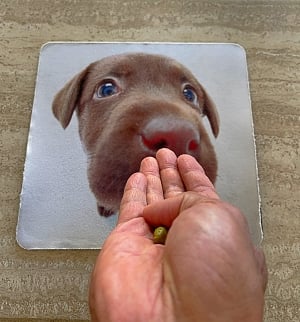
Give the command “Puppy Sit” while you have a kernel of food under the thumb of your right hand, in your palm. Rotate your palm up and raise it upward. When they sit you give them the treat and lavish them with praise “Good Puppy!”. The secret to this is using the hand signal with the treat. You do this when your right palm is facing upwards, the treat is under your thumb in your palm, and you raise your hand up and towards your dogs nose. Almost like you are lifting their chin (but don’t actually touch your puppy’s nose or chin). This will make your puppy’s head rise and usually sit. You can also do this while gently pushing your puppy’s butt down with your other hand. They will quickly get the idea when they sit and you give them the treat. You can slowly reduce the amount of moving your hand towards your dog’s chin with your right hand as they get more precise with the desired action.
How to train your dog to Come
The next command is something you’ll use very often. The hand signal is where your right arm is slightly extended, hand is open with your right thumb facing up. You make a motion like you are going to pat your chest with the palm of your hand where you end with your palm facing you. You give them command, “Puppy Come” while palming a kernal of food under your thumb, bring your palm towards your chest. The secret to this is when your palm is facing to your left, wave it right in front of your dogs nose as you bring your hand to you. Your dog should move towards you to follow the treat. That’s the start. When your dog moves towards you to follow the treat, that’s progress so give them the treat and praise them lavishly. Slowly position yourself further from your puppy. You’ll have to extend your arm a little so your hand will still come close to your dogs nose. Again, when they move towards you, reward them.
How to train your dog to Stay
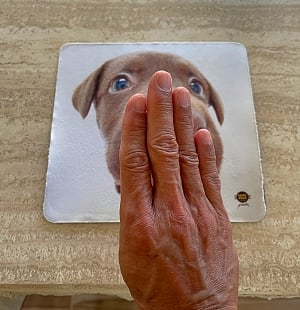
Teaching your dog to stay in one place can be a tricky one to teach. The reason is, most dogs really want to be near you, the dog owner. To teach this, give the verbal command, “Puppy Stay”. Use your right hand, again palming a kernel of food with your thumb and palm, and make the sign to stop. This is where your palm is facing your dog and your hand is bent back. This will take more progressive steps than the first basic dog commands. The progression is how long you want them to stay. At first, put your hand where your palm is right in front of your dogs nose. Hold his attentions by keeping your palm with the treat right in front of their nose and reward them when they remain still for at least a few seconds. Slowly withhold the positive reinforcement for a few seconds longer and having your hand further from your dog. Eventually you’ll be able to give them the command and hand signal from a distance and your dog will stay. Ideally, you should train your dog to Sit or Down, and then be commanded to Stay.
How to train your dog to Heel
Heel is where your dog comes to your right side. When you are stationary, your dog will sit on your right facing in the same direction as you are. The correct movement you are looking for is where your dog walks to your right side, makes a clockwise circle, and sits tight to your right leg. The hand signal is to pat your right palm against the right side of your right thigh. This will take even more progressive steps than Stay. Start with your dog facing you. With your right hand (with treat), show your dog your palm, and as they follow it, slowly move your hand to your right with your arm slightly extended. This will get your dog to move towards your right side. Then make a clockwise circle while guiding your dog with your palm facing down towards them. End the circle and pat your right side. The progressions you want to make with your dog is to get them to follow your hand. At first you may only get your dog to come to your right side. Good, reward them and keep going with the training session.
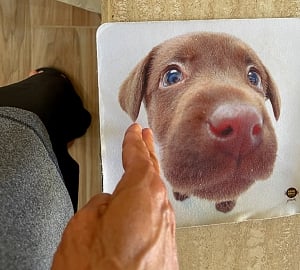
The 2nd version of heel is for your dog to walk to your left side, walk behind you, then sit tight to your right side then sit. In this case, start with the treat in your left hand, move it slowly behind you. When your left hand is behind you, switch the treat to your right hand (behind your back), and pat your right thigh. It’s a little trickier than the first version, but a useful command.
Once your dog has Heel down, start using it while walking on a leash. When you give the verbal command “Puppy Heel”, your puppy should walk tight to your right thigh. And when you stop, your puppy should sit. This takes a lot of practice but is very useful to keep your dog under control while out walking. Start out with short training sessions at home. Slowly move outside to your back yard or other familiar place. Eventually do training sessions in strange places when walking. It’s also a great way to keep your dog from pulling. A super secret pro tip to get your dog to watch your face is to use their favorite treat. What’s so secret about that? Well, you place it between your lips. That way, your dog’s eyes will be glued to your face. For our first puppy, we used small pieces of a hotdog. We sure had his attention ! This will really help you keep your dogs focus while walking and they are Heel-ing.
How to train your dog to Down
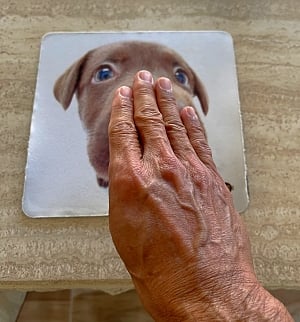
Laying down on command is one of the 7 commands for dog training. Like Sit, it’s one of the first ones to teach your pup. The hand signal is your hand is palm down (treat in palm) and you move your slightly extended arm down, like you are patting a table top. To progressively move your dog downward, give the command “Puppy Down” while moving your hand on top of your dog’s nose and slowly move your hand downward. This will encourage your dog to get lower. You can also try to move it slightly backwards and down which will get your dog to sit first then go down to the ground. Pro tip: If your pup tries to eat the treat out of your palm, try putting the treat between your fingers or even balancing it between your fingers near your knuckles.
How to train your dog to Off
Off is the command to stop whatever you are doing and sit as described earlier. We didn’t use a hand signal. It is a very valuable dog command to teach your puppy. To teach this, we found the easiest way is to put a piece of food on the ground near your puppy. Don’t say anything or direct their attention to it. When you puppy approaches it and lowers their nose towards it, give the command “Puppy OFF !”. Say it loudly to startle your puppy. This will make them pause a moment. As you move towards your puppy to reward them, have another treat in your right hand and use the early steps of Sit to get them to sit. As they sit, reward your dog with the treat and lavish praise. The side benefit of this training is that it teaches your dog to not eat food off the floor. During our dogs graduation from puppy training, the other pet parents rolled treats in front of our dog to try to get him to break form. It didn’t work lol.
How to train your dog to relieve themselves on command
Defecating or urinating on command is something you’ll use every day with your dog. Instead of saying something vulgar, we used “Get Busy”. It was a multiple syllable command, but it worked. No hand signal, just give the command when your puppy is getting ready to go. Tip: to start out, take your dog to where they normally go, and as they find the place they want to, give the command “Puppy Get Busy”, as soon as they start going, lavish them with praise. They might not be receptive to eating a treat while peeing or pooping, so try to give it to them or just wait until they are done. Your dog will usually look at you while going because they are in a vulnerable position and are looking to you for protection.
Additional tips for training your dog
Here are some tips and tricks to help with your dog training. The first one is to keep your training session duration shorter to start. As your dog gets better, you can slowly increase the sessions. When you introduce a new command, try to do it in the morning when your dog is more alert. When your dog is tired or hungry, they’ll have more difficulty learning new things.
After your dog has mastered the 7 basic commands, try things like Crate. This is where we crate trained our dogs so their “home” is their dog crate. They would use these to sleep in. Our dogs knew to go to their crate and that it was bedtime when we gave the command “Crate”.
Another fun party trick is “Spin”. We would point at them and rotate our index finger in a clockwise direction, leading their nose with the treat in our palm to get them to spin in a clockwise direction. Then we’d say “Other way” and have them spin in a counterclockwise direction. Other fun dog commands are Shake (and Other for the other paw), Five (for high five), and Bang (described above). To teach Bang, point your index finger at your puppy with a treat in your palm held there with your 3 fingers and your thumb up. The progression is move your hand towards you dogs nose, get them to Sit, then Down, and finally to roll over on their side by rolling your hand over. It’s a progressive trick but a fun one to have for parties.
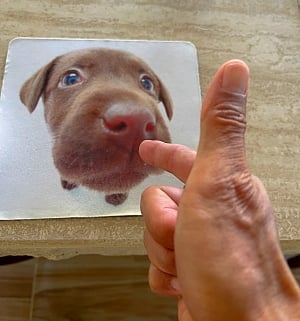
While puppies need a complete diet to grow and develop fully. Remember to add the amount of treats you are giving to your puppy to the total amount of food that you are giving throughout the day. This will help prevent the common causes of an overweight dog. See our article on 6 Top Causes and Solutions for Very Fat Dogs if you want more details.
Practice in new environments
This is a big one as training sessions at home are something very different to your dog in a new environment. Try a training session at the dog park when no one is there. Then, when the other pet parents and dogs are there, your dog will be more likely to obey. Try to go through your dogs repertoire of commands at different places around your house, neighborhood, and your relatives homes. The reason for this is to get your dog to always be attentive to your commands and respond accordingly.
Eventually wean your dog off of treats
Our first dog was super precise when we had treats. But as he got older and wiser, he would do the commands when we didn’t have treats, but not as swiftly or as crisply. So we would sometimes give him the treat, sometimes not. We would try to confuse him as much as possible so he wouldn’t know when we would have a treat or not. He did figure it out as his nose told him if we had a treat. So smart. Sometimes to smart for his own good.
You now know the first 7 commands for dogs, when to start training, and the tips, tricks, and secrets for success. This will go a long way towards a happy life with your new, well behaved puppy. And keeping your Pet Happy is what we all want.
